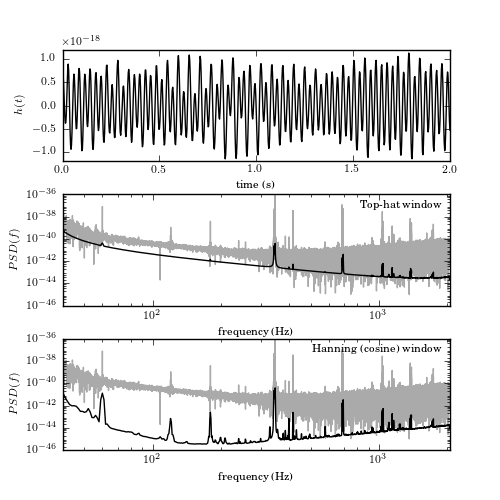Plot the power spectrum of LIGO data¶
Figure 10.6
LIGO data and its noise power spectrum. The upper panel shows a 2-second-long stretch of data (~8000 points; essentially noise without signal) from LIGO Hanford. The middle and bottom panels show the power spectral density computed for 2048 seconds of data, sampled at 4096 Hz (~8 million data values). The gray line shows the PSD computed using a naive FFT approach; the dark line uses Welch’s method of overlapping windows to smooth noise; the middle panel uses a 1-second-wide top-hat window and the bottom panel the so-called Hanning (cosine) window with the same width.

# Author: Jake VanderPlas
# License: BSD
# The figure produced by this code is published in the textbook
# "Statistics, Data Mining, and Machine Learning in Astronomy" (2013)
# For more information, see http://astroML.github.com
# To report a bug or issue, use the following forum:
# https://groups.google.com/forum/#!forum/astroml-general
import numpy as np
from matplotlib import pyplot as plt
from scipy import fftpack
from matplotlib import mlab
from astroML.datasets import fetch_LIGO_large
#----------------------------------------------------------------------
# This function adjusts matplotlib settings for a uniform feel in the textbook.
# Note that with usetex=True, fonts are rendered with LaTeX. This may
# result in an error if LaTeX is not installed on your system. In that case,
# you can set usetex to False.
from astroML.plotting import setup_text_plots
setup_text_plots(fontsize=8, usetex=True)
#------------------------------------------------------------
# Fetch the LIGO hanford data
data, dt = fetch_LIGO_large()
# subset of the data to plot
t0 = 646
T = 2
tplot = dt * np.arange(T * 4096)
dplot = data[4096 * t0: 4096 * (t0 + T)]
tplot = tplot[::10]
dplot = dplot[::10]
fmin = 40
fmax = 2060
#------------------------------------------------------------
# compute PSD using simple FFT
N = len(data)
df = 1. / (N * dt)
PSD = abs(dt * fftpack.fft(data)[:N / 2]) ** 2
f = df * np.arange(N / 2)
cutoff = ((f >= fmin) & (f <= fmax))
f = f[cutoff]
PSD = PSD[cutoff]
f = f[::100]
PSD = PSD[::100]
#------------------------------------------------------------
# compute PSD using Welch's method -- no window function
PSDW1, fW1 = mlab.psd(data, NFFT=4096, Fs=1. / dt,
window=mlab.window_none, noverlap=2048)
dfW1 = fW1[1] - fW1[0]
cutoff = (fW1 >= fmin) & (fW1 <= fmax)
fW1 = fW1[cutoff]
PSDW1 = PSDW1[cutoff]
#------------------------------------------------------------
# compute PSD using Welch's method -- hanning window function
PSDW2, fW2 = mlab.psd(data, NFFT=4096, Fs=1. / dt,
window=mlab.window_hanning, noverlap=2048)
dfW2 = fW2[1] - fW2[0]
cutoff = (fW2 >= fmin) & (fW2 <= fmax)
fW2 = fW2[cutoff]
PSDW2 = PSDW2[cutoff]
#------------------------------------------------------------
# Plot the data
fig = plt.figure(figsize=(5, 5))
fig.subplots_adjust(bottom=0.1, top=0.9, hspace=0.3)
# top panel: time series
ax = fig.add_subplot(311)
ax.plot(tplot, dplot, '-k')
ax.set_xlabel('time (s)')
ax.set_ylabel('$h(t)$')
ax.set_ylim(-1.2E-18, 1.2E-18)
# middle panel: non-windowed filter
ax = fig.add_subplot(312)
ax.loglog(f, PSD, '-', c='#AAAAAA')
ax.loglog(fW1, PSDW1, '-k')
ax.text(0.98, 0.95, "Top-hat window",
ha='right', va='top', transform=ax.transAxes)
ax.set_xlabel('frequency (Hz)')
ax.set_ylabel(r'$PSD(f)$')
ax.set_xlim(40, 2060)
ax.set_ylim(1E-46, 1E-36)
ax.yaxis.set_major_locator(plt.LogLocator(base=100))
# bottom panel: hanning window
ax = fig.add_subplot(313)
ax.loglog(f, PSD, '-', c='#AAAAAA')
ax.loglog(fW2, PSDW2, '-k')
ax.text(0.98, 0.95, "Hanning (cosine) window",
ha='right', va='top', transform=ax.transAxes)
ax.set_xlabel('frequency (Hz)')
ax.set_ylabel(r'$PSD(f)$')
ax.set_xlim(40, 2060)
ax.set_ylim(1E-46, 1E-36)
ax.yaxis.set_major_locator(plt.LogLocator(base=100))
plt.show()
